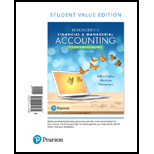
(1)
Note receivable:
Note receivable refers to a written promise for the amounts to be received within a stipulated period of time. This written promise is issued by a debtor or borrower to lender or creditor. Notes receivable is an asset of a business.
Interest on note:
Interest on note is the amount charged on the principal value of note for the privilege of borrowing money. Interest is to be paid by the borrower and to be received by the lender.
Maturity date:
Maturity date is the due date on note, on due date the borrower is supposed to repay the face value of the note along with interest.
The amount of maturity date and maturity value of each note.
(2)
To journalize: The entries, to record the establishment of note receivable, accrued interest revenue as on December 31, 2018, and collection of cash on principal and interest at maturity.
Want to see the full answer?
Check out a sample textbook solution
Chapter 8 Solutions
Horngren's Financial & Managerial Accounting, The Managerial Chapters, Student Value Edition (6th Edition)
- Franklin Company had a beginning raw materials inventory of $9,500. During the period, the company purchased $52,000 of raw materials on account. If the ending balance in raw materials was $7,000, the amount of raw materials transferred to work in process inventory is:arrow_forwardFinancial accounting problemarrow_forwardA company carries an average annual inventory of $4.3 million if it estimates the cost of capital is 13% so much costs are 9% and risk calls are 8%. What does it cost per year to carry this inventory?arrow_forward
- Which accounting principle requires that expenses be matched with revenues in the period in which they are incurred to produce those revenues? A) Going Concern Principle B) Matching Principle C) Consistency Principle D) Conservatism Principlearrow_forwardNeed helparrow_forwardA delivery van cost $64,300 when purchased and has a $58,700 balance in the accumulated depreciation account. If the van is discarded, Tread line Logistics will record: (1) Loss on disposal, $5,600 (2) Gain on disposal, $2,000 (3) No gain or loss because it was discarded (4) Loss of $58,700arrow_forward
- Could you help me solve this financial accounting question using appropriate calculation techniques?arrow_forwardAccurate Value Hardware began in 2019 with a credit balance of $47,000 in the allowance for sales returns account. Sales and cash collections from customers during the year were $663,000 and $615,000, respectively. Accurate Value estimates that 7.2% of all sales will be returned. In 2019, customers returned merchandise for a credit of $36,000 to their accounts. Accurate Value's 2019 income statement would report net sales of__.arrow_forwardAccurate answerarrow_forward

 AccountingAccountingISBN:9781337272094Author:WARREN, Carl S., Reeve, James M., Duchac, Jonathan E.Publisher:Cengage Learning,
AccountingAccountingISBN:9781337272094Author:WARREN, Carl S., Reeve, James M., Duchac, Jonathan E.Publisher:Cengage Learning, Accounting Information SystemsAccountingISBN:9781337619202Author:Hall, James A.Publisher:Cengage Learning,
Accounting Information SystemsAccountingISBN:9781337619202Author:Hall, James A.Publisher:Cengage Learning, Horngren's Cost Accounting: A Managerial Emphasis...AccountingISBN:9780134475585Author:Srikant M. Datar, Madhav V. RajanPublisher:PEARSON
Horngren's Cost Accounting: A Managerial Emphasis...AccountingISBN:9780134475585Author:Srikant M. Datar, Madhav V. RajanPublisher:PEARSON Intermediate AccountingAccountingISBN:9781259722660Author:J. David Spiceland, Mark W. Nelson, Wayne M ThomasPublisher:McGraw-Hill Education
Intermediate AccountingAccountingISBN:9781259722660Author:J. David Spiceland, Mark W. Nelson, Wayne M ThomasPublisher:McGraw-Hill Education Financial and Managerial AccountingAccountingISBN:9781259726705Author:John J Wild, Ken W. Shaw, Barbara Chiappetta Fundamental Accounting PrinciplesPublisher:McGraw-Hill Education
Financial and Managerial AccountingAccountingISBN:9781259726705Author:John J Wild, Ken W. Shaw, Barbara Chiappetta Fundamental Accounting PrinciplesPublisher:McGraw-Hill Education





